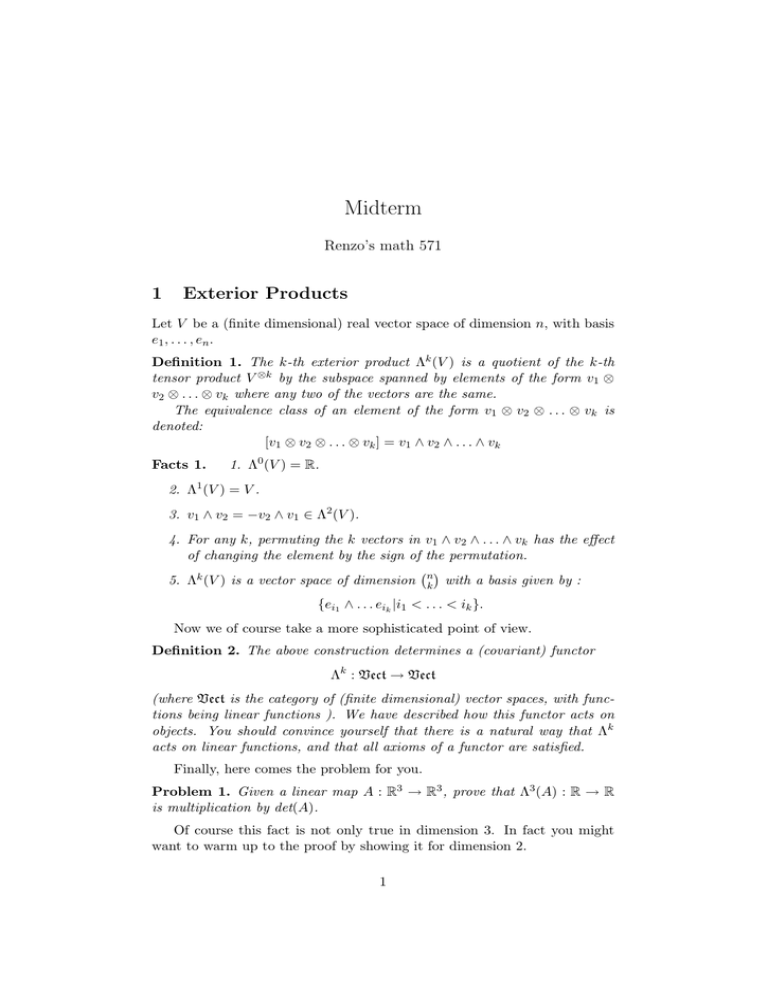Midterm 1 Exterior Products Renzo’s math 571
advertisement

Midterm
Renzo’s math 571
1
Exterior Products
Let V be a (finite dimensional) real vector space of dimension n, with basis
e1 , . . . , e n .
Definition 1. The k-th exterior product Λk (V ) is a quotient of the k-th
tensor product V ⊗k by the subspace spanned by elements of the form v1 ⊗
v2 ⊗ . . . ⊗ vk where any two of the vectors are the same.
The equivalence class of an element of the form v1 ⊗ v2 ⊗ . . . ⊗ vk is
denoted:
[v1 ⊗ v2 ⊗ . . . ⊗ vk ] = v1 ∧ v2 ∧ . . . ∧ vk
Facts 1.
1. Λ0 (V ) = R.
2. Λ1 (V ) = V .
3. v1 ∧ v2 = −v2 ∧ v1 ∈ Λ2 (V ).
4. For any k, permuting the k vectors in v1 ∧ v2 ∧ . . . ∧ vk has the effect
of changing the element by the sign of the permutation.
5. Λk (V ) is a vector space of dimension nk with a basis given by :
{ei1 ∧ . . . eik |i1 < . . . < ik }.
Now we of course take a more sophisticated point of view.
Definition 2. The above construction determines a (covariant) functor
Λk : Vect → Vect
(where Vect is the category of (finite dimensional) vector spaces, with functions being linear functions ). We have described how this functor acts on
objects. You should convince yourself that there is a natural way that Λk
acts on linear functions, and that all axioms of a functor are satisfied.
Finally, here comes the problem for you.
Problem 1. Given a linear map A : R3 → R3 , prove that Λ3 (A) : R → R
is multiplication by det(A).
Of course this fact is not only true in dimension 3. In fact you might
want to warm up to the proof by showing it for dimension 2.
1
2
Homology and Cohomology
From the point of view of algebra, homology and cohomology are essentially
the same functor. The only difference consists in how we index the groups
in our chain or cochain complexes. What distinguishes the two theories
geometrically is that a dualization occurs in the construction of the cochain
complex and makes cohomology a contravariant functor.
However, it should come as no big surprise that any property of homology
that depends exclusively on commutative algebra (i.e. where we started the
proof with having a complex of groups, and it was of no importance how
that complex was cooked up), should carry through for cohomology.
Problem 2. Choose ONE of the following properties, and prove it. You are
not allowed to use the Universal coefficient theorem!
2.1
Long exact Sequence for a Pair
For A ⊆ X, define relative cohomology as follows. Define relative cochains
groups C k (X, A; G) = Hom(Ck (X, A), G). You can think of relative cochains
as functions that vanish on chains supported in A. Show that there is an
exact sequence:
0 → C k (X, A; G) → C k (X; G) → C k (A; G) → 0
Understand relative coboundary maps, and finally use the short exact sequence to deduce a long exact sequence in cohomology. You don’t need to
re-prove the snake lemma!
2.2
Homotopy Invariance
If f ∼ g : X → Y , then f ∗ = g ∗ : H k (Y ; G) → H k (X; G). Deduce that
homotopic spaces have isomorphic cohomology.
2.3
Equivalence of simplicial and singular cohomology
If X is a CW complex define the cellular cochain complex by dualizing the
cellular chain complex. Define cellular cohomology and show it is isomorphic
to singular cohomology.
2.4
Mayer-Vietoris
For A, B ⊆ X such that the union of the interiors of A and B cover X, there
is a long exact sequence:
. . . → H k (X; G) → H k (A; G)⊕H k (B, G) → H k (A∩B; G) → H k+1 (X; G) → . . .
2


